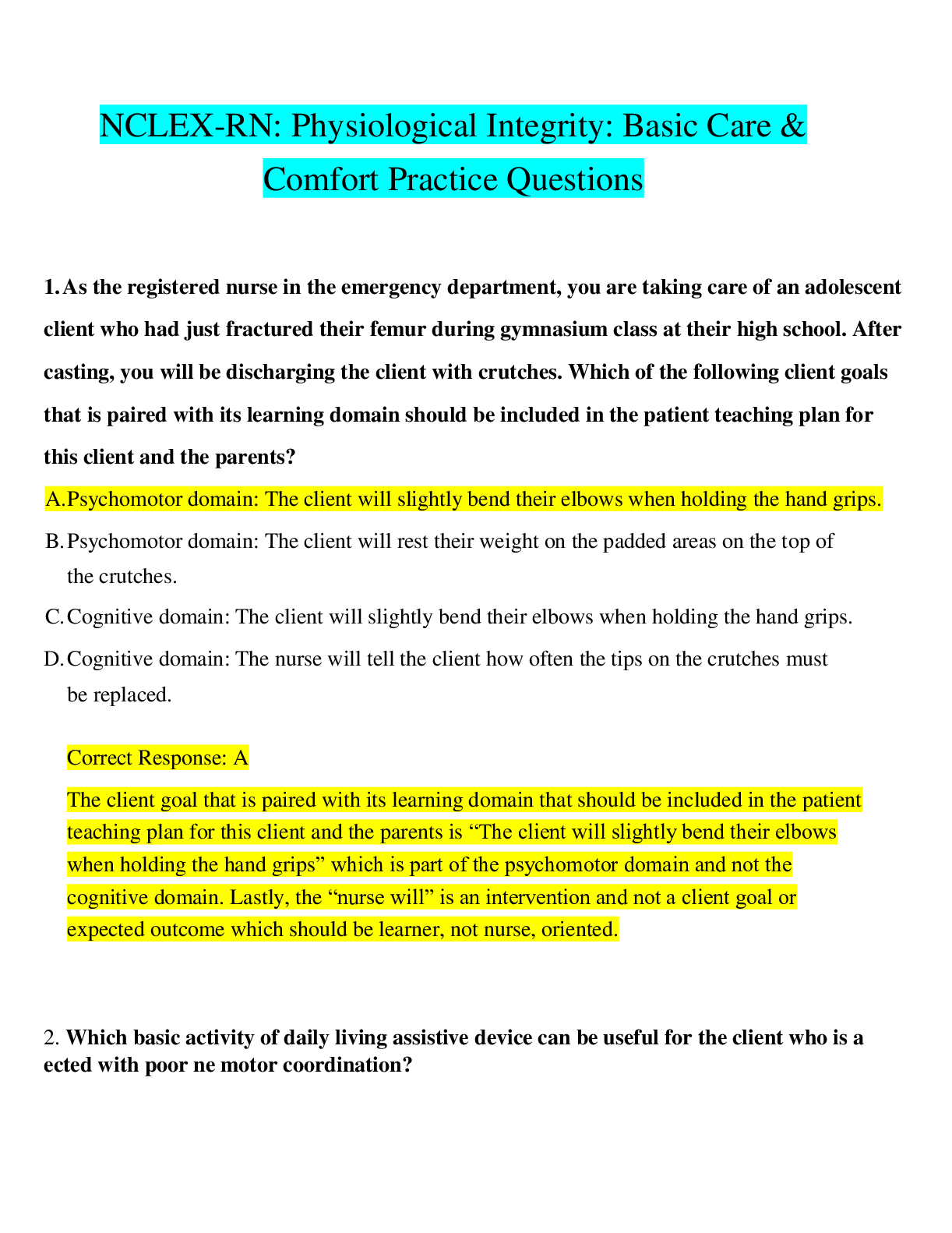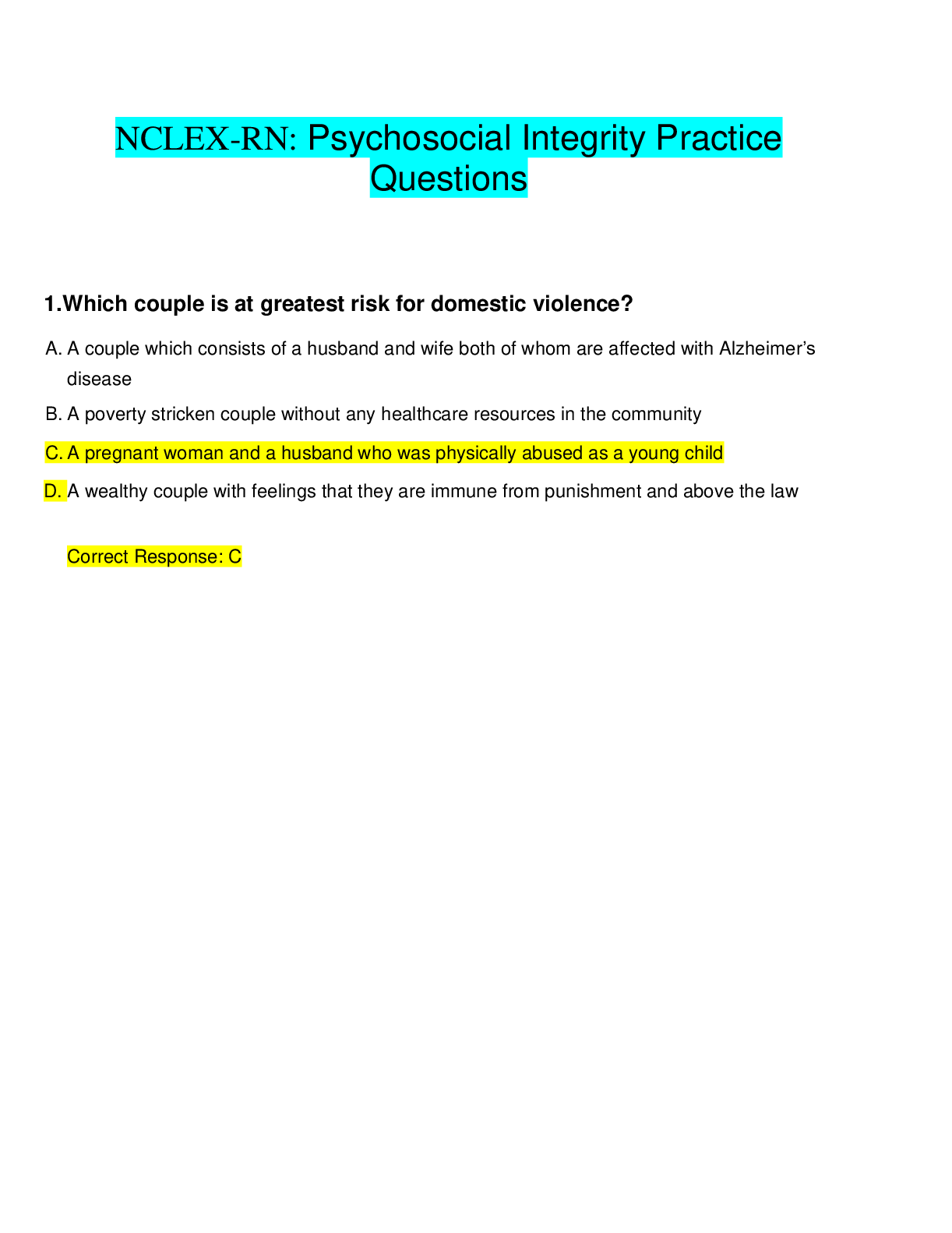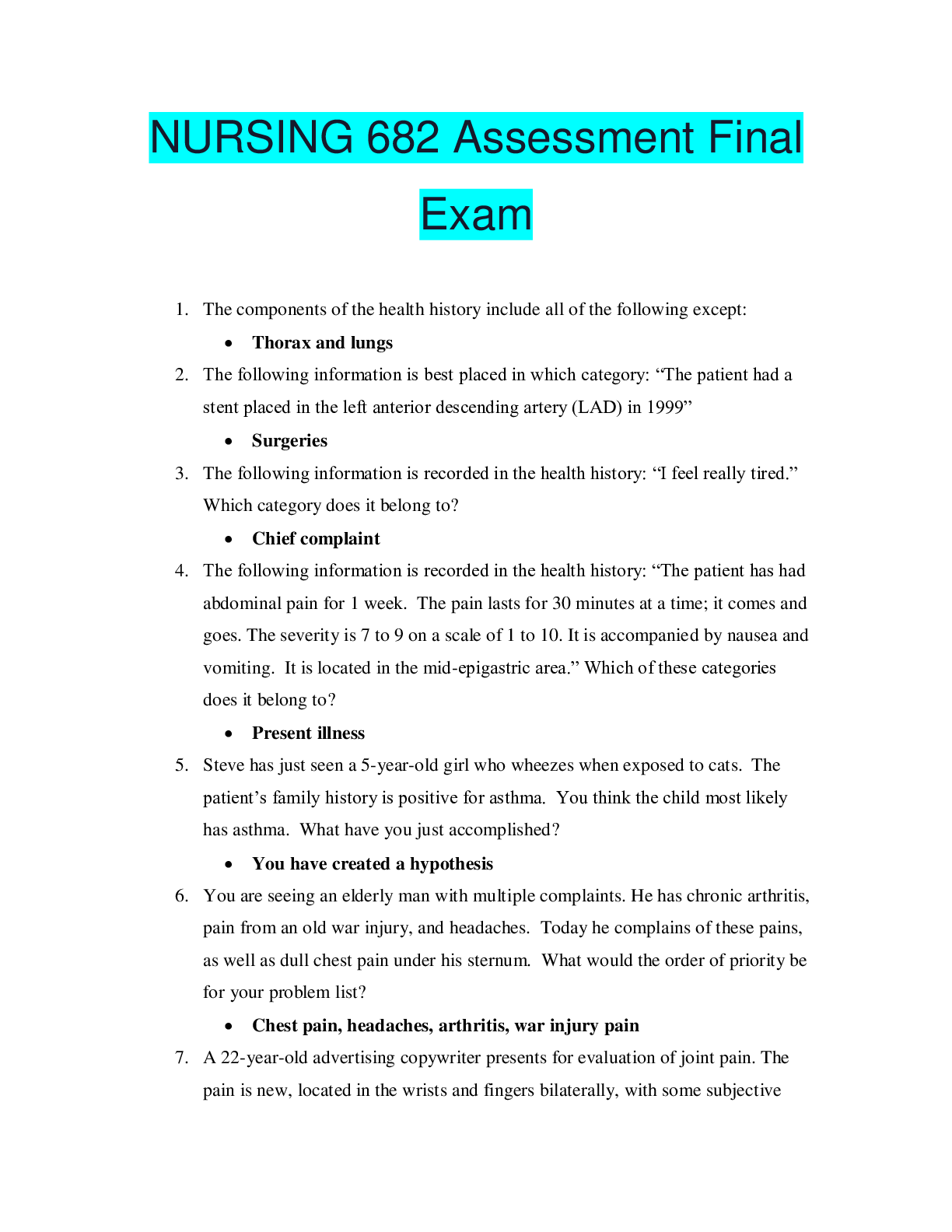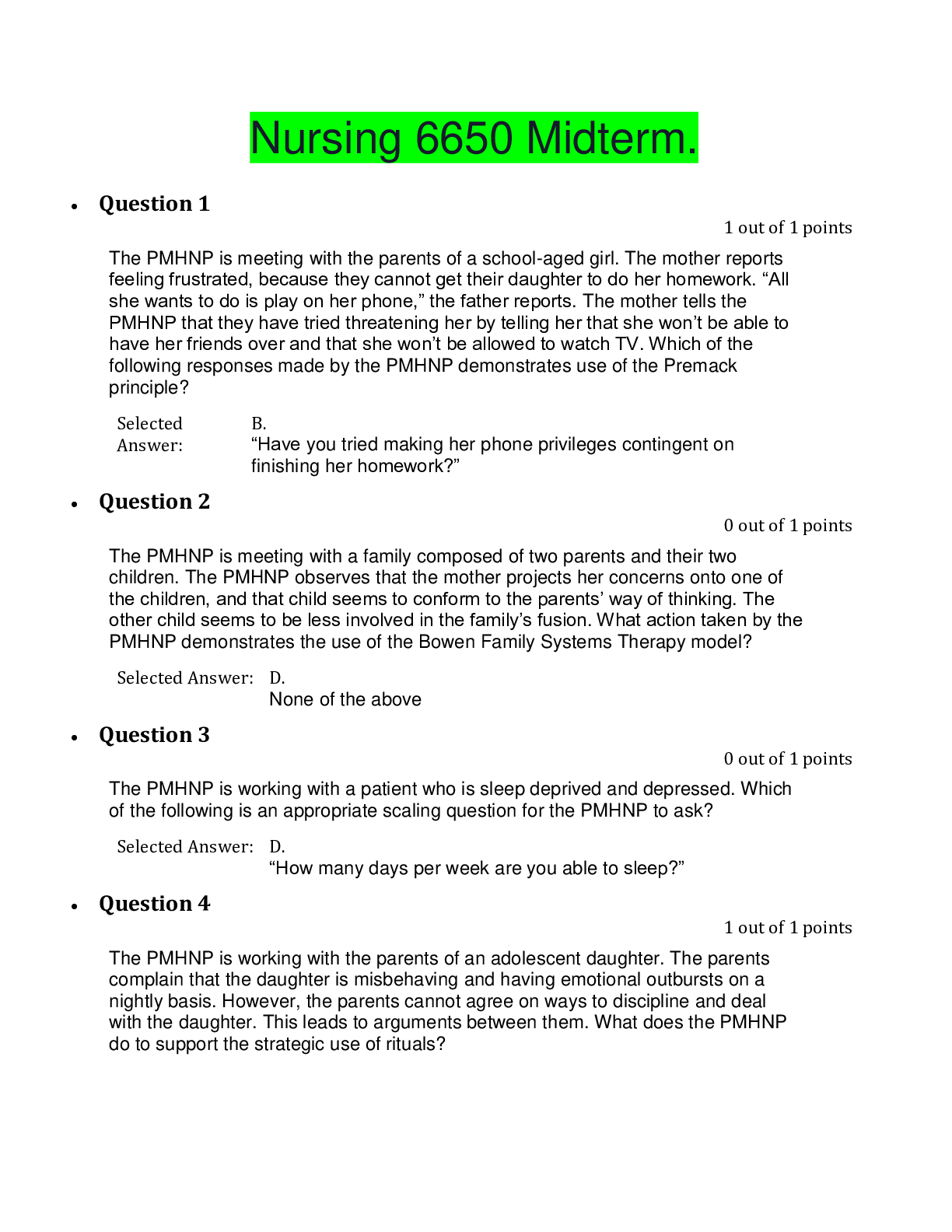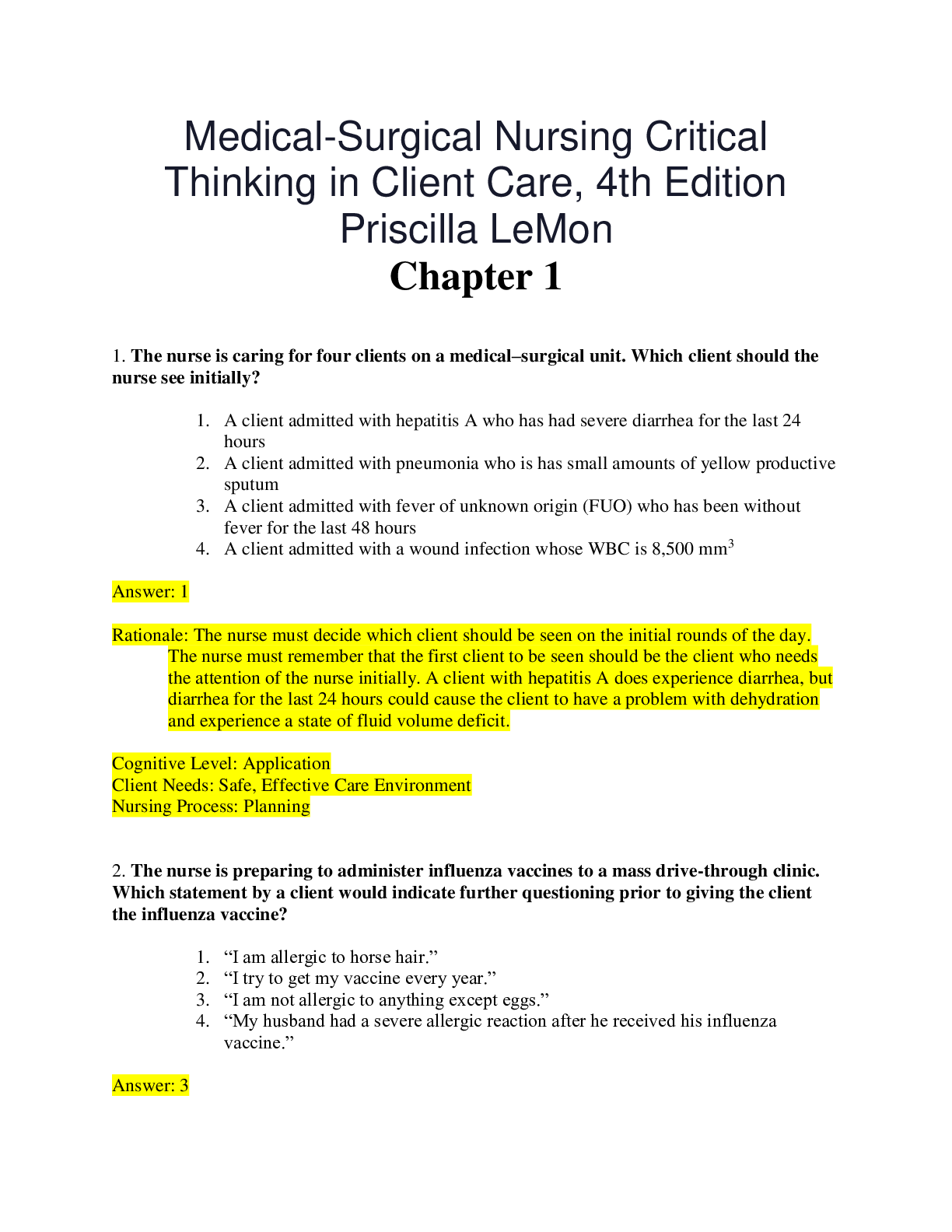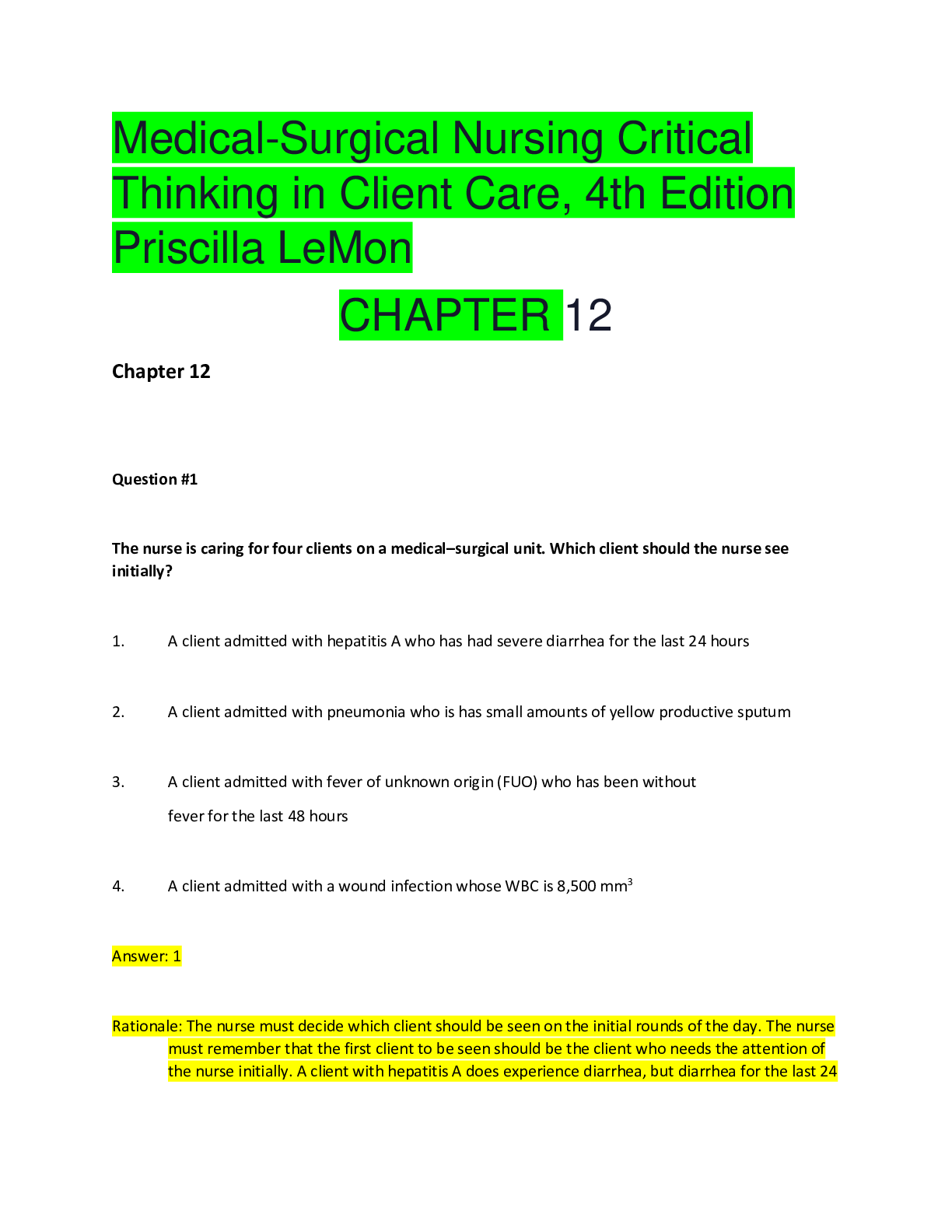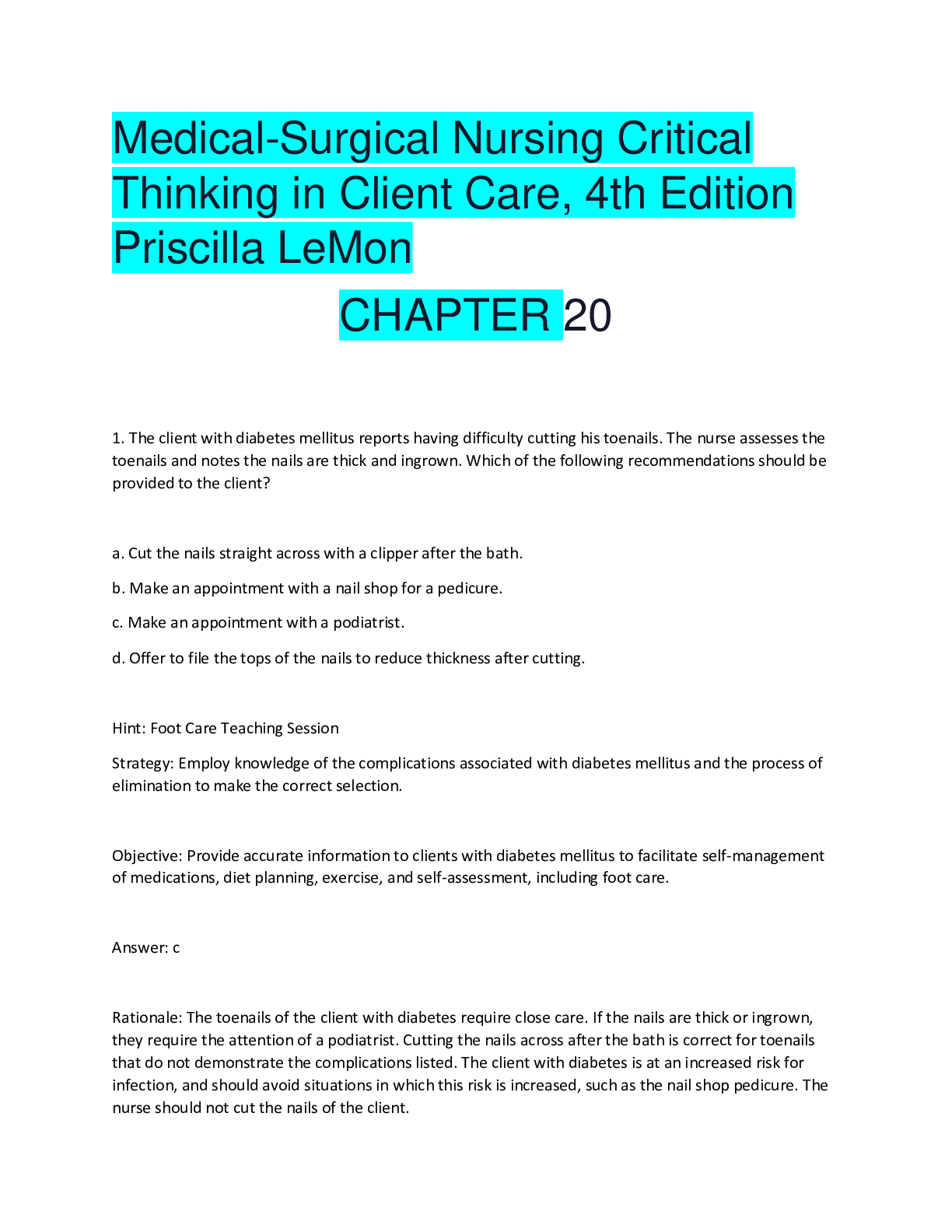*NURSING > QUESTIONS & ANSWERS > Grand Canyon University > NUR 634 Chapter 20 (ALL CORRECT ANSWERS AND RATIONALE) (All)
Grand Canyon University > NUR 634 Chapter 20 (ALL CORRECT ANSWERS AND RATIONALE)
Document Content and Description Below
CHAPTER 20 1. Which of the following changes are expected in vision as part of the normal aging process? A) Cataracts B) Glaucoma C) Macular degeneration D) Blurring of near vision ... 2. A 72-year-old retired truck driver comes to the clinic with his wife for evaluation of hearing loss. He has noticed some decreased ability to hear what his wife and grandchildren are saying to him. He admits to lip-reading more. He has a history of noise exposure in his young adult years: He worked as a sound engineer at a local arena and had to attend a lot of concerts. Based on this information, what is the most likely finding regarding his hearing acuity? A) Loss of acuity for middle-range sounds B) Increase of acuity for low-range sounds C) Loss of acuity for high-range sounds D) Increase of acuity for high-range sounds 3. A 79-year-old retired banker comes to your office for evaluation of difficulty with urination; he gets up five to six times per night to urinate and has to go at least that often in the daytime. He does not feel as if his bladder empties completely; the strength of the urinary stream is diminished. He denies dysuria or hematuria. This problem has been present for several years but has worsened over the last 8 months. You palpate his prostate. What is your expected physical examination finding, based on this description? A) Normal size, smooth B) Normal size, boggy C) Enlarged size, smooth D) Enlarged size, boggy 4. A 70-year-old retired auto mechanic comes to your office because his neighbor is concerned about his memory. The patient himself admits to misplacing his keys more often and forgets what he is supposed to buy from the grocery store and where he has parked the car. He denies getting lost in familiar places. Upon further questioning, he states that his wife of 40 years died 8 months ago; his three children live in three different states; and he has limited his activities because the people he interacted with were “his wife's friends, not his.” He drinks a six-pack of beer daily; he does not smoke or use illicit drugs. You perform a mini-mental state examination and obtain a total score of 24 out of 28. Based on this information, what is your most likely diagnosis? A) Benign forgetfulness B) Dementia C) Meningitis D) Depression 5. An 85-year-old retired teacher comes to your office for evaluation of weakness. You obtain a complete history, perform a thorough physical examination, and order laboratory tests. You diagnose her with hyperthyroidism. Based on her age, which of the atypical symptoms of hyperthyroidism is more likely to be seen? A) Fatigue B) Weight loss C) Tachycardia D) Anorexia 6. A 78-year-old retired seamstress comes to the office for a routine check-up. You obtain an ECG (electrocardiogram) because of her history of hypertension. You diagnose a previous myocardial infarction and ask her if she had any symptoms related to this. Which of the following symptoms would be more common in this patient's age group for an acute myocardial infarction? A) Chest pain B) Syncope C) Pain radiating into the left arm D) Pain radiating into the jaw 7. An 88-year-old retired piano teacher comes for evaluation of fatigue. You notice that her clothes are hanging loosely off her frame and that she has lost 15 pounds. She is unaware of this. Her husband of 63 years died a few months ago. You ask the patient to complete a Rapid Screen for Dietary Intake. Which of the following statements is considered to be part of this rapid screen? A) I eat more than two meals per day. B) I drink one glass of alcohol every day. C) Without wanting to, I have lost or gained 10 pounds in the last 6 months. D) I eat with at least one other person most of the time. 8. An 89-year-old retired school principal comes for an annual check-up. She would like to know whether or not she should undergo a screening colonoscopy. She has never done this before. Which of the following factors should not be considered when discussing whether she should go for this screening test? A) Life expectancy B) Time interval until benefit from screening accrues C) Patient preference D) Current age of patient 9. Which of the following booster immunizations is recommended in the older adult population? A) Tetanus B) Diphtheria C) Measles D) Mumps 10. You are asked to perform a home safety assessment for an 87-year-old retired farmer who lives by himself. Which of the following is not considered to be an increased risk for falls? A) Loose electrical cords B) Slippery or irregular surfaces C) Chairs at awkward angles D) Bright lighting 11. A 73-year-old retired accountant comes to your office for her annual examination. She has incontinence of urine when she coughs or sneezes. She takes several medications for control of hypertension and diabetes. You use the DIAPERS mnemonic to assess the cause of her incontinence. All of the following are items represented by the mnemonic except for: A) Atrophic vaginitis B) Depression C) Pharmaceuticals D) Restricted mobility 12. Which of the following brief screening measures is useful in assessing memory? A) Three-item recall B) Serial 7s C) Spelling “world” backward D) Copying intersecting pentagrams 13. Which of the following questions is part of the screening for physical disability? A) Are you able to go shopping for groceries or clothes? B) Are you able to walk one block? C) Are you able to pass the driver's license test? D) Are you able to perform light dusting and pick up after yourself around the house? 14. It is summer and an 82-year-old woman is brought to you from her home after seeing her primary care doctor 2 days ago. She was started on an antibiotic at that time. Today, she comes to the emergency room not knowing where she is or what year it is. What could be a likely cause of this? A) Alzheimer's dementia B) Stroke C) Delirium D) Meningitis 15. Blood pressure abnormalities found more commonly in Western elderly include which of the following? A) Isolated elevation of the diastolic BP B) Narrow pulse pressure C) Elevation of the systolic BP D) Elevation of the BP with standing Ans: C Feedback: Isolated systolic hypertension is common in the elderly because of stiffening of the large arteries. This is often accompanied by widening of the pulse pressure. Orthostatic BP changes are often seen with postural changes and can account for falls as well. 16. Which of the following represents age-related changes in the lungs? A) Decrease in chest wall compliance B) Speed of expiration increases C) Increase in respiratory muscle strength D) Increased elastic recoil of lung tissue 17. Mrs. Stanton is a 79-year-old widow who presents to your office for a routine BP visit. You note a new pulsatile mass in the right neck at the carotid artery. Which of the following is the most likely cause for this? A) Anxiety B) Carotid artery aneurysm C) Kinking of the artery D) Tortuous aorta 18. Mr. Chin is an 82-year-old man who comes to your office for a routine check. On examination, you notice a somewhat high-pitched murmur in the second right intercostal space during systole. It does not radiate and the rest of his examination is normal for his age. Which is true of the most likely cause of this murmur? A) It often decreases carotid upstroke. B) It carries with it increased risk for cardiovascular disease. C) It is usually accompanied by an S3 gallop. D) It is found in 10% of otherwise normal elderly patients. 19. Mrs. Buckley is a 75-year-old widow who wants you to look at her teeth because over the past 2 weeks she has had right-sided jaw pain when eating. It does not occur otherwise. She also has had a headache. Which of the following should be considered? A) Palpation of her temples B) Dental referral C) Ultrasound of the gallbladder D) Inquiry about anosmia 20. Which of the following is commonly seen in aging men? A) Erectile dysfunction in 20% of all men B) Testicles ride higher within the scrotum C) Strong response to visual erotic cues D) Persistent sexual interest 21. Which of the following accompanies decreased ovarian function? A) Increased sleep B) Diminution of sexual interest C) Enlargement of the clitoris D) Decrease in vaginal secretions 22. You are examining an elderly man and notice the following: decreased vibration sense in the feet and ankles, diminished gag reflex, right patellar reflex less than the left, and diminished abdominal reflexes. Which of these is abnormal? A) Decreased vibration sense B) Diminished gag reflex C) Diminished right patellar reflex compared to the left D) Diminished abdominal reflexes 23. Mrs. Glynn is 90 years old and lives alone. She is able to bathe, dress, prepare her food, and transfer from bed to chair independently. She has children in the area who help her with her medications and transportation needs. Which of the following is considered an instrumental activity of daily living? A) Bathing B) Dressing C) Preparing food D) Transferring from bed to chair 24. Mr. Kelly comes to you today for a burning pain in his lower abdomen. This has gone on for 2 months. He has received radiation for prostatic cancer for the past quarter. What assumptions could you draw from this? A) This represents persistent pain. B) His pain reporting is likely to be unreliable. C) There are “red flags” present. D) He is depressed. 25. Mr. White's son brings him in today because he notes that Mr. White has not been himself lately. He seems forgetful and has not taken care of himself as he normally does. He has reported falling twice at home to his son and has telephoned late at night because of insomnia. His blood pressure and diabetes have been difficult to control and his warfarin dosing has become more difficult. Which of the following should you suspect? A) Alzheimer's dementia B) Alcohol use C) Urinary tract infection D) Stroke 26. Claire's daughter brings her in today after Claire fell at her home. Which assessments are indicated at this time? A) Orthostatic vital signs B) Review of her medications C) Assessment of gait and balance D) All of the above 27. Mrs. Geller is somewhat quiet today. She has several bruises of different colors on the ulnar aspects of her forearms and on her abdomen. She otherwise has no complaints and her diabetes and hypertension are well managed. Her son from out of state accompanies her today and has recently moved in to help her. What should you suspect? A) Overuse of aspirin B) Frequent falls C) Elder abuse D) Depression 28. A patient comes to you for the appearance of red patches on his forearms that have been present for several months. They remain for several weeks. He denies a history of trauma. Which of the following is likely? A) Actinic keratoses B) Pseudoscars C) Actinic purpura D) Cherry angiomas 29. On routine screening you notice that the cup-to-disc ratio of the patient's right eye is 1:2. What ocular condition should you suspect? A) Macular degeneration B) Diabetic retinopathy C) Hypertensive retinopathy D) Glaucoma 30. Which of the following is true of assessment of the vascular system in the elderly? A) Fewer than one third of patients with peripheral vascular disease have symptoms of claudication. B) An aortic width of 2.5 cm is abnormal. C) Bruits are commonly benign findings. D) Orthostatic blood pressure and pulse are not useful in this population. [Show More]
Last updated: 1 year ago
Preview 1 out of 13 pages

Buy this document to get the full access instantly
Instant Download Access after purchase
Add to cartInstant download
We Accept:

Reviews( 0 )
$10.00
Document information
Connected school, study & course
About the document
Uploaded On
Apr 19, 2020
Number of pages
13
Written in
Additional information
This document has been written for:
Uploaded
Apr 19, 2020
Downloads
0
Views
44













